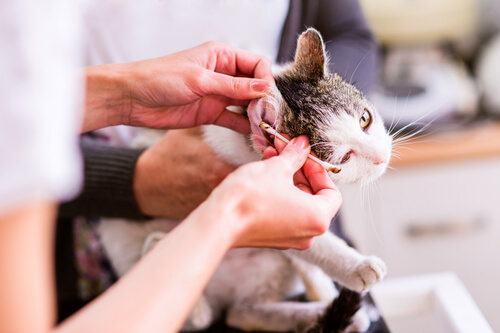Ear Mites in Cats: Symptoms and Treatment

There are many everyday illnesses and complaints that can affect your pet. Fortunately, ear mites are as easy to treat as they are common. The treatment for ear mites is really quick and simple, and will greatly improve your pet’s quality of life.
No breed of cat is immune to ear mites, but there are some that are more susceptible to them than others. Long-haired cats, for example, offer a veritable parasite paradise to these microscopic creatures. Because their immune systems are still developing, kittens are also slightly more prone to mites than other cats.
Ear mites in cats: symptoms
Like any ailment, learning to recognize the early signs of ear mites is important for your cat’s health and well-being. You need to keep a close eye on your pet, and watch out for any changes in its behavior. When it comes to ear mites, one of the first signs is excessive scratching.
Scratching, strange, jerky movements, a strange mood, or unusual behavior are all good indicators that something’s not quite right with your pet. If you start to notice some of these symptoms in your cat, it’s best to consult with a vet as soon as possible.

A cat suffering from ear mites may react in a number of different ways. The most common symptoms include:
- Sudden head movements: irritated by mites biting their ears, your cat will react by shaking its head, trying to get rid of them.
- Scratching: if you notice your cat scratching its ears excessively, it’s likely that they are being irritated by something. Ticks and mites are the most likely culprits.
- Black discharge: if the mite infestation is not treated quickly, the ears will start to produce a black discharge. Normally, the inside of a cat’s ears is a light pink, so the appearance of this dark substance should alert you to the problem immediately. It looks like dark earwax, and is usually the result of a secondary fungal or bacterial infection.
What to do if you think your cat has mites?
The symptoms of ear mites are usually fairly obvious, which means owners normally catch them early on. The first step is to take your pet to a vet, who will be able to examine their ears with an otoscope.
If the vet isn’t sure whether the irritation is caused by mites or a potential infection, they will take a sample and analyze it under the microscope to get a definitive answer. This will allow them to prescribe the best course of treatment as soon as possible.
If the eardrum is okay (which is usually the case) all your pet will need is a few ear drops, which are applied directly to the ears. The dosage and number of days you’ll need to administer the ear drops varies from case to case.

Treatment and preventative care
Naturally, it’s best to try to avoid the problem altogether. The best way to do this is to keep your pet’s environment clean. You also need to take to your pet to the vet for regular check-ups.
Anti-mite treatments are fairly effective. However, it’s best to use them in moderation, as the smell can actually put your cat off its blankets and toys.
A good antiparasitic will help keep mites, ticks, fleas, heartworms and other parasites at bay. Antiparasitics come in a range of different forms, such as collars, pipettes and tablets. All of these are fairly effective, although some experts recommend some over others.
Your vet will act in the best interests of your pet, prescribing the most effective course of treatment. Within a few days, the mites will be gone, and your pet will be back to its happy, healthy self.
There are many everyday illnesses and complaints that can affect your pet. Fortunately, ear mites are as easy to treat as they are common. The treatment for ear mites is really quick and simple, and will greatly improve your pet’s quality of life.
No breed of cat is immune to ear mites, but there are some that are more susceptible to them than others. Long-haired cats, for example, offer a veritable parasite paradise to these microscopic creatures. Because their immune systems are still developing, kittens are also slightly more prone to mites than other cats.
Ear mites in cats: symptoms
Like any ailment, learning to recognize the early signs of ear mites is important for your cat’s health and well-being. You need to keep a close eye on your pet, and watch out for any changes in its behavior. When it comes to ear mites, one of the first signs is excessive scratching.
Scratching, strange, jerky movements, a strange mood, or unusual behavior are all good indicators that something’s not quite right with your pet. If you start to notice some of these symptoms in your cat, it’s best to consult with a vet as soon as possible.

A cat suffering from ear mites may react in a number of different ways. The most common symptoms include:
- Sudden head movements: irritated by mites biting their ears, your cat will react by shaking its head, trying to get rid of them.
- Scratching: if you notice your cat scratching its ears excessively, it’s likely that they are being irritated by something. Ticks and mites are the most likely culprits.
- Black discharge: if the mite infestation is not treated quickly, the ears will start to produce a black discharge. Normally, the inside of a cat’s ears is a light pink, so the appearance of this dark substance should alert you to the problem immediately. It looks like dark earwax, and is usually the result of a secondary fungal or bacterial infection.
What to do if you think your cat has mites?
The symptoms of ear mites are usually fairly obvious, which means owners normally catch them early on. The first step is to take your pet to a vet, who will be able to examine their ears with an otoscope.
If the vet isn’t sure whether the irritation is caused by mites or a potential infection, they will take a sample and analyze it under the microscope to get a definitive answer. This will allow them to prescribe the best course of treatment as soon as possible.
If the eardrum is okay (which is usually the case) all your pet will need is a few ear drops, which are applied directly to the ears. The dosage and number of days you’ll need to administer the ear drops varies from case to case.

Treatment and preventative care
Naturally, it’s best to try to avoid the problem altogether. The best way to do this is to keep your pet’s environment clean. You also need to take to your pet to the vet for regular check-ups.
Anti-mite treatments are fairly effective. However, it’s best to use them in moderation, as the smell can actually put your cat off its blankets and toys.
A good antiparasitic will help keep mites, ticks, fleas, heartworms and other parasites at bay. Antiparasitics come in a range of different forms, such as collars, pipettes and tablets. All of these are fairly effective, although some experts recommend some over others.
Your vet will act in the best interests of your pet, prescribing the most effective course of treatment. Within a few days, the mites will be gone, and your pet will be back to its happy, healthy self.
All cited sources were thoroughly reviewed by our team to ensure their quality, reliability, currency, and validity. The bibliography of this article was considered reliable and of academic or scientific accuracy.
- Blog Tiendanimal. Cómo mantener libres de ácaros las orejas de tu gato. tiendanimal.es/articulos/mantener-libres-acaros-las-orejas-gato/
- Nexo centros veterinarios. Abril de 2015. nexoveterinarios.es/es/consejos-perros-gatos/control-parasitos/como-saber-si-mi-gato-tiene-acaros-en-los-oidos
This text is provided for informational purposes only and does not replace consultation with a professional. If in doubt, consult your specialist.








